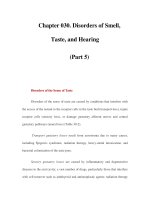Chapter 061. Disorders of Granulocytes and Monocytes (Part 9) Chronic Granulomatous Disease Chronic pot
Bạn đang xem bản rút gọn của tài liệu. Xem và tải ngay bản đầy đủ của tài liệu tại đây (55.89 KB, 5 trang )
Chapter 061. Disorders of Granulocytes
and Monocytes
(Part 9)
Chronic Granulomatous Disease
Chronic granulomatous disease (CGD) is a group of disorders of
granulocyte and monocyte oxidative metabolism. Although CGD is rare, with an
incidence of 1 in 200,000 individuals, it is an important model of defective
neutrophil oxidative metabolism. Most often CGD is inherited as an X-linked
recessive trait; 30% of patients inherit the disease in an autosomal recessive
pattern. Mutations in the genes for the four proteins that assemble at the plasma
membrane account for all patients with CGD. Two proteins (a 91-kDa protein,
abnormal in X-linked CGD, and a 22-kDa protein, absent in one form of
autosomal recessive CGD) form the heterodimer cytochrome b-558 in the plasma
membrane. Two other proteins (47 and 67 kDa, abnormal in the other autosomal
recessive forms of CGD) are cytoplasmic in origin and interact with the
cytochrome after cell activation to form NADPH oxidase, required for hydrogen
peroxide production. Leukocytes from patients with CGD have severely
diminished hydrogen peroxide production. The genes involved in each of the
defects have been cloned and sequenced and the chromosome locations identified.
Patients with CGD characteristically have increased numbers of infections due to
catalase-positive microorganisms (organisms that destroy their own hydrogen
peroxide). When patients with CGD become infected, they often have extensive
inflammatory reactions, and lymph node suppuration is common despite the
administration of appropriate antibiotics. Aphthous ulcers and chronic
inflammation of the nares are often present. Granulomas are frequent and can
obstruct the gastrointestinal or genitourinary tracts. The excessive inflammation
probably reflects failure to inhibit the synthesis or degradation of chemoattractants
and antigens, leading to persistent neutrophil accumulation. Impaired killing of
intracellular microorganisms by macrophages may lead to persistent cell-mediated
immune activation and granuloma formation. Autoimmune complications such as
immune thrombocytopenic purpura and juvenile rheumatoid arthritis are also
increased in CGD. In addition, discoid lupus is more common in X-linked carriers.
Disorders of Phagocyte Activation
Phagocytes depend on cell-surface stimulation to induce signals that evoke
multiple levels of the inflammatory response, including cytokine synthesis,
chemotaxis, and antigen presentation. Mutations affecting the major pathway that
signals through NF-κB have been noted in patients with a variety of infection
susceptibility syndromes. If the defects are at a very late stage of signal
transduction, in the protein critical for NF-κB activation known as the NF-κB
essential modulator (NEMO), then affected males develop ectodermal dysplasia
and severe immune deficiency with susceptibility to bacteria, fungi, mycobacteria,
and viruses. If the defect in NF-κB activation is closer to the signaling source, in
the IL-1 receptor–associated kinase 4 (IRAK4), then children have a marked
susceptibility to pyogenic infections early in life but develop resistance to
infection later.
Mononuclear Phagocytes
The mononuclear phagocyte system is composed of monoblasts,
promonocytes, and monocytes, in addition to the structurally diverse tissue
macrophages that make up what was previously referred to as the
reticuloendothelial system. Macrophages are long-lived phagocytic cells capable
of many of the functions of neutrophils. They are also secretory cells that
participate in many immunologic and inflammatory processes distinct from
neutrophils. Monocytes leave the circulation by diapedesis more slowly than
neutrophils and have a half-life in the blood of 12–24 h.
After blood monocytes arrive in the tissues, they differentiate into
macrophages ("big eaters") with specialized functions suited for specific anatomic
locations. Macrophages are particularly abundant in capillary walls of the lung,
spleen, liver, and bone marrow, where they function to remove microorganisms
and other noxious elements from the blood. Alveolar macrophages, liver Kupffer
cells, splenic macrophages, peritoneal macrophages, bone marrow macrophages,
lymphatic macrophages, brain microglial cells, and dendritic macrophages all have
specialized functions. Macrophage-secreted products include lysozyme, neutral
proteases, acid hydrolases, arginase, complement components, enzyme inhibitors
(plasmin, α
2
-macroglobulin), binding proteins (transferrin, fibronectin,
transcobalamin II), nucleosides, and cytokines (TNF-α; IL-1, -8, -12, -18). IL-1
(Chaps. 17 and 308) has many functions, including initiating fever in the
hypothalamus, mobilizing leukocytes from the bone marrow, and activating
lymphocytes and neutrophils. TNF-α is a pyrogen that duplicates many of the
actions of IL-1 and plays an important role in the pathogenesis of gram-negative
shock (Chap. 265). TNF-α stimulates production of hydrogen peroxide and related
toxic oxygen species by macrophages and neutrophils. In addition, TNF-α induces
catabolic changes that contribute to the profound wasting (cachexia) associated
with many chronic diseases.
Other macrophage-secreted products include reactive oxygen and nitrogen
metabolites, bioactive lipids (arachidonic acid metabolites and platelet-activating
factors), chemokines, CSFs, and factors stimulating fibroblast and vessel
proliferation. Macrophages help regulate the replication of lymphocytes and
participate in the killing of tumors, viruses, and certain bacteria (Mycobacterium
tuberculosis and Listeria monocytogenes). Macrophages are key effector cells in
the elimination of intracellular microorganisms. Their ability to fuse to form giant
cells that coalesce into granulomas in response to some inflammatory stimuli is
important in the elimination of intracellular microbes and is under the control of
IFN-γ. Nitric oxide induced by IFN-γ is an important effector against intracellular
parasites, including tuberculosis and Leishmania.
Macrophages play an important role in the immune response (Chap. 308).
They process and present antigen to lymphocytes and secrete cytokines that
modulate and direct lymphocyte development and function. Macrophages
participate in autoimmune phenomena by removing immune complexes and other
substances from the circulation. Polymorphisms in macrophage receptors for
immunoglobulin (FcγRII) determine susceptibility to some infections and
autoimmune diseases. In wound healing, they dispose of senescent cells, and they
contribute to atheroma development. Macrophage elastase mediates development
of emphysema from cigarette smoking.









